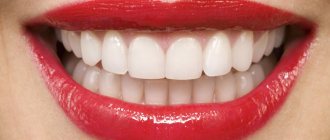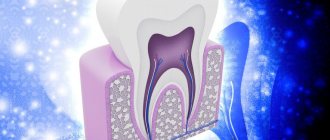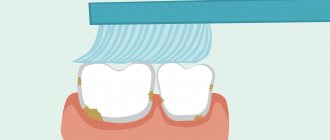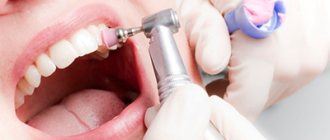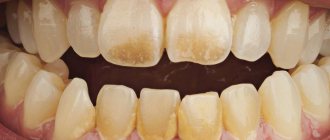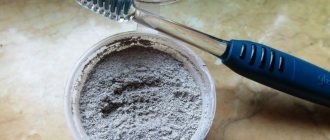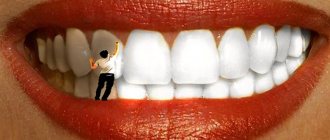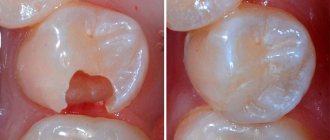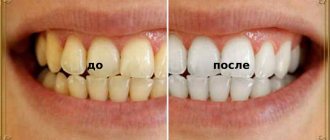Families who have experienced the whims of the baby due to swelling of the gums and pain during teething, after a while, will again face the test. At 2-4 years old, many children's milk units begin to deteriorate. Parents have a new problem - how to protect their teeth from caries. There is nothing worse than watching a child suffer from pain, trying to persuade him to undergo treatment, and worrying about children’s tears in the dental office.
Our Family Dentist clinic offers dental fluoridation (coating teeth with fluoride varnish) as a proven and effective method of caries prevention . After the procedure, tooth enamel strengthens and becomes less sensitive to the acidic environment created by the bacterial community. Painful reactions to hot and cold foods are reduced. In the long term, children are less likely to suffer from caries , and parents are not nervous when visiting a doctor, and dental treatment costs are reduced.
BENEFITS OF FLUORIDE LAC
Enamel is the most durable tissue of the human body, however, over time it inevitably loses its properties.
Exposure to aggressive substances, organic acids, hot/cold food and drinks changes the structure of the enamel and leads to a thinning of the protective layer. Enamel also suffers from teeth whitening procedures. Therefore, in dentistry they use the method of coating teeth with Fluoride varnish. The ability of fluoride to protect enamel from damage has been scientifically proven through laboratory studies. Modern industry produces special toothpastes with fluoride, and the pharmaceutical industry produces fluoride-containing drugs.
Fluoride varnish is a fluorine-containing varnish that is applied to the enamel in order to preserve it from external aggression. This drug is a solution of a viscous consistency with the aroma of pine needles, which includes:
- shellac;
- sodium fluoride;
- fir balsam;
- ethanol;
- chloroform.
After application, this composition dries, forming a protective coating - a film. This film reliably protects the tooth crown for a long time, while also providing a therapeutic effect. Fluoride varnish coating has the following effects on teeth:
- deprives microorganisms of activity;
- forms reliable enamel protection;
- helps restore the mineral structure of the tooth;
- heals gingival tissues and gives them elasticity.
Dental plaque contains thousands of microorganisms that feed on sugars. The presence of the film deprives microorganisms of the ability to digest and absorb sugar, which prevents their active activity and the release of aggressive acid.
Fluoride's ability to attract calcium molecules helps restore the mineral structure of bone tissue. Fluoride draws calcium from saliva and it integrates into tooth enamel, strengthening it. Thus, treating enamel with fluoride varnish prevents common dental diseases - caries and periodontitis. Fluoridation increases the shelf life of fillings and reduces the sensitivity of enamel to cold/hot foods.
What is fluoride varnish?
Fluoride varnish is a specialized product. It is used in dental clinics for therapeutic and preventive purposes. However, it can be purchased at some pharmacies. The active ingredient in fluoride varnish is sodium fluoride, NaF. Recently, conventional fluoride varnish has been replaced by products created on the basis of aminofluoride. This is a new product that is included in the products of some oral care companies. They contain additional components: shellac, ethyl alcohol, pine extract.
Fluoride varnish is produced in dark glass bottles with a capacity of up to 30 ml. It is a dark thick liquid. The kit is equipped with a brush or other tool for applying to teeth.
INDICATIONS FOR USE
Many citizens are sure that the most important microelement for teeth is calcium. This is partly true: calcium is responsible for the structural strength of bones. However, fluorine is important for enamel; it is what ensures the strength of its structure. Fluoride is absorbed not only with water and food; this microelement is well absorbed by the enamel from the outside. Therefore, scientists created the drug Fluorlak. Let's consider the question: Fluoride varnish instructions for use.
Enamel protection with a fluoride-containing agent is carried out in dental clinics. However, you can coat your teeth with fluoride varnish yourself. A home procedure will be much cheaper and will save time. Who is the fluoridation procedure indicated for? A lack of fluoride in drinking water provokes massive caries disease, so fluoridation is primarily indicated for people living in the area. The use of the drug is also indicated:
- people with high enamel permeability;
- pregnant and elderly people;
- children over six years of age living in areas with low fluoride content in water;
- with mechanical destruction of enamel: chips, cracks;
- before placing dentures (after grinding the crown);
- after ultrasonic cleansing;
- with a wedge-shaped defect.
A contraindication to fluoridation is an excess of fluoride in bone tissue (fluorosis) and sensitivity to the components of the drug.
FLUORIDATION IN THE DOCTOR'S OFFICE
How does the fluoride varnish treatment process work? The dentist uses a special brush or roller for this. Before the procedure begins, the crowns of the teeth are treated: plaque is removed, and any hard formations are removed. Then salivation is eliminated and the surface of the teeth is dried.
The coating begins with the lower jaw, after which it moves to the upper dentition. When the treatment is completed, the patient remains with his mouth open for some time until the composition dries completely. After fluoridation, you should not brush your teeth or eat hard foods for a day, so as not to damage the fresh layer of varnish. Since it is impossible to apply a thick layer of fluoride in one procedure, fluoridation is carried out several times at intervals of 3-4 days.
How long will fluoride varnish last in dentistry? Typically, the protective film lasts for six months, so after this period of time the procedure should be repeated. Does this product change the color of the enamel? No, a similar effect was not noticed after using Fluoride Lac.
FLUORIDE VARNISH FOR TEETH AT HOME
How to apply fluoride varnish for teeth at home? Coating teeth with the composition is not difficult, however, buying the drug is quite problematic: it cannot be found in pharmacies. To purchase this product (Fluorolak Omega), you must place an order in stores specializing in the sale of dental products.
How to apply fluoride varnish instructions:
- Clean your mouth with paste.
- Dry the surface of the teeth: to do this, wipe the crowns with a cotton swab or place gauze pads between the lips/cheek and isolate the teeth from saliva.
- Soak a cotton swab in the solution and rub the enamel (it is better to start treating the crowns of the bottom row).
- Keep your mouth open until the mixture dries (takes about five minutes).
Important! After treating enamel with fluorine-containing varnish, you should not eat for 12 hours, so it is advisable to carry out the procedure in the evening. The sooner the food touches the coating, the less time it will last.
What difficulties may arise during the home fluoridation procedure? Do not allow the composition to come into contact with the mucous membrane. It is necessary to carefully monitor the application of fluoride varnish to the teeth. If the product gets on the mucous membrane, it can cause negative consequences - a burn.
Why are teeth fluoridated?
At a norm of 0.7-0.8 mg/l, drinking water in Minsk contains fluorine less than 0.4 mg/l. Not all kids love sea fish, and the microelement content in other products is not sufficient for the strength of dental tissues. Fluoridation of teeth in children, the benefits of which have been proven by numerous studies, strengthens the enamel layer. Stable fluorides, penetrating into the crystal lattice, form fluorapatites, which are poorly soluble in an acidic environment, and restore the density of the enamel. Labile (mobile) fluorides located near the tooth surface slow down the removal of minerals, inhibit the synthesis (compound) of lactic acid by streptococci and substances that promote the adhesion of bacteria and the formation of dental plaque.
DO YOU NEED TO FLUORIDE YOUR MILK TEETH?
Many parents do not pay due attention to their child’s baby teeth: they will fall out anyway. Such frivolity can lead to damage to the rudiments of molar permanent teeth. Fluoridation remineralizes the enamel and saturates it with fluoride-containing microelements. This provides:
- resistance of baby teeth to decay;
- reduction of bacterial activity in the oral cavity;
- strengthening the enamel structure.
How is the procedure for protecting baby teeth carried out at the dentist? There are several ways to apply fluoride varnish to baby teeth:
- A simple method: the composition is applied with a brush, then illuminated with a special lamp.
- Deep fluoridation: first, the surface is coated with a composition containing calcium and magnesium salts, then a composition of calcium and copper is applied.
- Express fluoridation: disposable trays with fluoride are used on the teeth.
- Mouthguard fluoridation: a procedure using reusable mouthguards filled with a medicinal composition, which can be performed at home before bed.
- Electrophoresis: remineralization of tooth enamel is carried out using fluoride ions.
If you are prone to caries, the procedure should be repeated every 6 months. If the baby has healthy teeth, prophylaxis is carried out once a year.
Caries prevention can also be carried out using children's gels and special pastes. You should also create a special menu, which should include oats, fish, buckwheat, rice, apples, tea (green and black).
Answers to parents' questions
- What are the indications for dental fluoridation?
Protection against caries is needed during the period of changing teeth. In children, thin enamel and dentin are quickly destroyed. Within a few weeks, the infection can affect the pulp, peri-root tissues, and subsequently reach the rudiments of permanent teeth lying under the roots of milk teeth. As a result, teeth grow with grooves, chips and stains, and an irregularly shaped crown. Infected buds may die and not erupt. Fluoride saturation is useful for increased sensitivity of the enamel, before installing braces and after wearing them. We recommend fluoridation to reduce the risk of tooth decay, even if there are no dental problems.
- What is the optimal age for fluoride prophylaxis?
Fluoridation of teeth for children, starting from 3 years of age, helps preserve milk units until the physiological change and reduce the risk of improper formation of a permanent bite. Teeth respond well to fluoride saturation, microcracks are sealed, and areas with chalky stains are restored.
- Is fluoridation harmful for children?
Fluoride ions are released slowly and do not pass through the mucous membrane. Fluoride-containing products and fluoride varnish do not cause excess fluoride in the body. We follow the dosage and acceptable frequency, and do not prescribe a procedure if it is not necessary.
Don't wait for caries to develop; take care to protect fragile enamel.
Make an appointment at pediatric dentistry +375 29 604-61-61.
TIPS FOR STRENGTHENING ENAMEL
Taking care of your teeth should include proper nutrition. Without it, preventative medical procedures will be of little benefit. A complete menu to strengthen teeth enamel should include the following foods:
- dairy products: they all contain phosphorus and calcium;
- hard root vegetables - carrots, radishes, apples, cabbage: chewing activates the secretion of saliva, which cleans the crown of the teeth;
- parsley: essential oils of this plant suppress the activity of microorganisms, which affects the cleanliness and safety of teeth and the strength of their coating;
- green tea: tea leaves contain fluoride in their structure, which prevents the formation of plaque and the accumulation of bacteria on the teeth;
- chicken eggs and seafood: they contain iodine, which helps strengthen the enamel.
It is necessary to take care of strengthening teeth from the appearance of the first primary incisor. Those parents who consider their baby’s baby teeth to be temporary and unimportant are deeply mistaken. It is the health of baby teeth that determines the health of future molars.
After six years, a child definitely needs to prevent caries using the drug Fluorlak Omega and other gels/solutions for teeth. Treatment must be prevented by preventing diseases, then dental health will be strong and the enamel will be strong.
